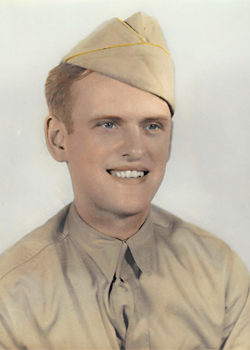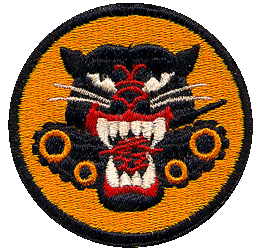 Stanley J. Dunaj
Stanley J. Dunaj
Biography: Stanley James Dunaj was born on September 30, 1917, in Chicago, Illinois. He was the son of Peter (Piotr) J. and Angeline V. Dunaj, who were both Polish immigrants and he attended Lane Technical High School through the 10th grade.
In 1936, Stanley married the former Helen V. Czarniecka in New Jersey. Helen was the daughter of Tomasz Czaja and Maria Zukowska who were also immigrants from Poland. The new couple would make their home in Chicago. The census for 1940, says that he was working as a dryer at a tannery but just prior to the war, Stanley’s military registration card identifies that he was working at the Dole Valve Company in Chicago, soldering brass valves and pipe fittings.
Service Time: Stanley entered the service on December 5, 1941, at Fort Custer in Michigan. He enlisted just two days before Pearl Harbor was attacked. After his basic training, he was probably assigned to a field artillery unit but was eventually assigned to C Company of the 702nd Tank Destroyer Battalion. He served initially as part of the five man crew of a tank destroyer and through most of his service in the unit. During the last ten months, after being promoted to Corporal, his responsibilities expanded and he was chosen to take charge in the absence of the TD Commander. He also assisted with loading, aiming, firing, driving and maintaining the TD.
Stanley trained with the unit at a number of military facilities throughout the U.S., including Fort Benning, Georgia, Fort Bragg, North Carolina, Camp Hood, Texas, Camp Gruber, Oklahoma, Camp Myles Standish and Fort Devens, Massachusetts. They also took part in the Louisiana Maneuvers.
The 702nd was equipped w ith M18 tank destroyers before shipping out, which they did on February 14, 1944, from the Boston port. They arrived in Gourock, Scotland, on February 25, 1944, only to be issued M10 tank destroyers while there. After four months of additional training, they were loaded on transports and landed at Omaha Beach in France, on June 11th. Entering the line at Livry, on July 2nd, they formed part of the 2nd Armored Division’s spearhead during the Cobra breakout in late July. The unit fought at Mortain and established the first contact with Canadian forces during encirclement of the Falaise Pocket.
ith M18 tank destroyers before shipping out, which they did on February 14, 1944, from the Boston port. They arrived in Gourock, Scotland, on February 25, 1944, only to be issued M10 tank destroyers while there. After four months of additional training, they were loaded on transports and landed at Omaha Beach in France, on June 11th. Entering the line at Livry, on July 2nd, they formed part of the 2nd Armored Division’s spearhead during the Cobra breakout in late July. The unit fought at Mortain and established the first contact with Canadian forces during encirclement of the Falaise Pocket.
It was on August 23rd that Stanley would set himself apart from the others during actions against the enemy during their movements eastward toward the Cherbourg or Cotentin peninsula. In a letter to Stanley’s nephew, dated May 9, 2000, his former Company Commander Captain Harry H. Hart recalled that they were tasked with securing roadblocks on roads around the peninsula to stop thousands of German troops from escaping. Sadly, we only have a partial copy of his actual Bronze Star certificate but from what we can see, Private First Class Stanley J. Dunaj was cited for Heroic Achievement against the enemy during the action. The Bronze Star award is noted in G.O. (General Order) #50 from Headquarters, 2nd Armored Division, dated October 12, 1944.
The unit entered Belgium on September 5th and crossed the German border near Gangelt, followed by fighting against the Siegfried Line along the Wurm River in October and November. They were re-equipped with M36 tank destroyers and supported the drive to the Roer River before moving into the Ardennes in December. On February 21, 1945, Cpl. Dunaj and Sgt. Leininger were singled out for a commendation. The two men had been sent to Company C of the 654th Tank Destroyer Battalion to help familiarize their men on the M-36 tank destroyers. They were praised for their discipline and eagerness to help. The 654th, C Company Commander, 1st Lt. Scott P. Cooper, stated:
“It has been largely through the help of these two men that we have been able to make the conversion from the M-10 to M-36s so quickly”
The 702nd returned to the Roer in February and then to the Rhine River in March, eventually reaching the Ruhr, Weser and finally the Elbe River in April. Stanley received credit for the campaigns of Normandy, Northern France, Rhineland, Ardennes-Alsace and Central Europe. In addition to the Bronze Star Medal mentioned earlier he also received the EAME Ribbon and the Good Conduct Medal and shared in the unit’s award of the Belgian Croix de Guerre. Stanley shipped home on September 23, 1945 and arrived back in the U.S. on October 2nd. He left the service at the rank of Corporal at Camp Grant, IL.
Once back home in Illinois, Stanley found work in the U.S. Postal Service in Chicago. He and Helen did not have any children. Stanley passed away on December 30, 2006, and was buried in the Saint Adalbert Cemetery in Niles, IL. I want to thank Stanley’s nephew, Retired Army Major, Jeff Dunaj, for providing the information and photos used in this tribute.
